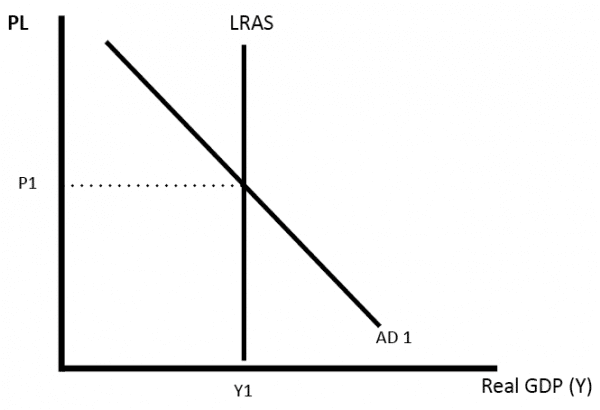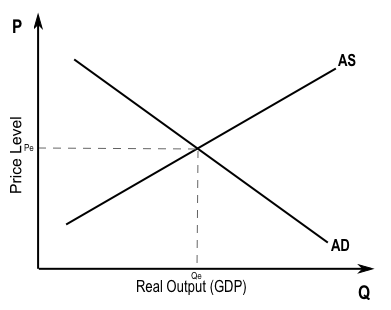AQA Specification focus:
‘The various demand-side and supply-side determinants of short-run growth of real national income and the long-run trend rate of economic growth.’
Introduction
Economic growth is driven by multiple interacting factors. Short-run changes arise mainly from demand-side influences, while long-run growth depends on sustained supply-side improvements in productivity and capacity.
Short-Run Economic Growth
Short-run economic growth refers to an increase in real national income caused by a rise in the utilisation of existing resources. It does not require an increase in productive capacity.

This diagram contrasts short-run and long-run economic growth within the AD/AS model. Short-run growth is shown by a rightward shift in the AD curve, while long-run growth is represented by an outward shift in the LRAS curve, reflecting an increase in productive capacity. Source
Demand-Side Determinants
Short-run growth is primarily influenced by aggregate demand (AD). When AD increases, spare capacity is used up, raising output and employment. Key determinants include:
Consumer spending (C): Changes in disposable income, confidence, interest rates, and taxation affect household consumption.
Investment (I): Firms may increase investment due to business confidence, lower borrowing costs, or government incentives.
Government spending (G): Fiscal policy can directly raise demand through infrastructure, welfare, or defence spending.
Net exports (X – M): A rise in exports or fall in imports boosts domestic demand, often influenced by exchange rates and global demand conditions.
Short-run economic growth: An increase in real GDP resulting from higher utilisation of existing factors of production, driven by rises in aggregate demand.
A rise in AD shifts the AD curve rightward, raising output in the short run. However, the impact depends on the degree of spare capacity in the economy.
Demand-Side Shocks
Growth can be accelerated or slowed by unexpected changes:
A positive demand shock (e.g., consumer boom, fiscal stimulus) raises output.
A negative demand shock (e.g., financial crisis, global slowdown) reduces output.
Long-Run Economic Growth
Long-run economic growth refers to sustained increases in an economy’s productive capacity, often measured as the trend rate of growth. It depends on supply-side improvements rather than temporary demand boosts.

The diagram illustrates long-run economic growth as an outward shift in the Long-Run Aggregate Supply (LRAS) curve, representing a higher productive capacity supported by improvements in technology, capital, and labour. Source
Supply-Side Determinants
Supply-side factors shift the long-run aggregate supply (LRAS) curve outward, enabling higher sustainable growth. Key determinants include:
Investment in physical capital: Infrastructure, machinery, and technology improvements increase productive potential.
Human capital development: Education and training enhance worker productivity and adaptability.
Labour force growth: Population growth, immigration, or higher participation rates expand available labour.
Innovation and technological progress: New methods, products, and processes raise efficiency and productivity.
Institutional factors: Stable governance, property rights, and effective financial markets encourage investment and innovation.
Resource availability: Access to natural resources and energy supports higher production possibilities.
Long-run economic growth: An increase in the productive potential of the economy, reflected in outward shifts of the long-run aggregate supply curve and higher trend growth rates.
Long-Run Trend Rate of Growth
This is the sustainable rate at which an economy can grow without generating inflationary pressure. It reflects improvements in factor productivity and efficiency.
Interplay Between Short-Run and Long-Run Growth
While demand-side changes influence short-term fluctuations, long-term growth relies on supply-side improvements. However, they are interrelated:
Strong demand in the short run can encourage greater investment, stimulating long-run growth.
Conversely, weak demand may discourage investment, limiting supply-side progress.
Persistent inflationary pressures from excessive demand growth can harm long-run stability.
Example Interactions
Education spending: Raises AD in the short run while improving human capital in the long run.
Infrastructure projects: Boost construction activity immediately while enhancing productive capacity later.
Constraints on Growth
Both short-run and long-run growth can be constrained by various barriers:
Inflationary pressures: If growth exceeds productive capacity, demand-pull inflation emerges.
Balance of payments constraints: Heavy reliance on imports may restrict growth if deficits widen.
Supply bottlenecks: Lack of skilled workers or limited infrastructure prevents sustained output increases.
Global conditions: Trade shocks, commodity price changes, and international financial flows impact growth prospects.
Demand-Side vs Supply-Side Policies to Promote Growth
Governments often combine short-run demand-side measures with long-run supply-side reforms.
Demand-Side Policies
Expansionary fiscal policy (higher G, tax cuts).
Expansionary monetary policy (lower interest rates, quantitative easing).
Supply-Side Policies
Investment in education, training, and skills.
Incentives for innovation and research.
Deregulation and improving competition.
Infrastructure development.
These policies differ in timescale: demand-side policies often have immediate but temporary effects, whereas supply-side policies support sustainable growth.
Conclusion of Specification Alignment
The AQA specification requires students to understand that the determinants of short-run growth focus on demand-side influences that increase real national income, while the determinants of long-run growth are supply-side factors that raise the trend rate of growth by expanding productive capacity. Both perspectives are crucial for understanding economic performance and policy-making.
FAQ
Demand-side shocks directly affect aggregate demand, such as a sudden fall in consumer confidence or a government stimulus package. These influence output in the short run.
Supply-side shocks alter the economy’s productive capacity, for example through a technological breakthrough or disruption in energy supplies. These have longer-lasting effects on the trend rate of growth.
In the short run, investment raises aggregate demand by increasing spending on capital goods, boosting real GDP.
In the long run, investment improves productive capacity through new technology, infrastructure, and skills, shifting the long-run aggregate supply curve outward.
In the short run, a rise in employment increases aggregate demand and output without changing capacity.
In the long run, higher participation rates, immigration, or education reforms enhance the quality and size of the workforce, driving sustainable growth.
Yes, resource availability can support higher levels of production.
However, long-run growth increasingly depends on efficiency, innovation, and technology, as resource reliance can create vulnerability to depletion and price volatility.
The trend rate depends heavily on productivity improvements.
Higher labour productivity means more output per worker.
Capital productivity ensures better returns from investment.
Total factor productivity captures efficiency gains from innovation and organisational improvements.
All these factors help sustain non-inflationary growth over time.
Practice Questions
Define short-run economic growth and explain how it differs from long-run economic growth. (2 marks)
1 mark: Correct definition of short-run growth as an increase in real GDP due to higher utilisation of existing resources.
1 mark: Clear distinction that long-run growth is an increase in the economy’s productive capacity or trend rate of growth.
Discuss the role of demand-side and supply-side factors in determining economic growth in both the short run and the long run. (6 marks)
Up to 2 marks: Explanation of short-run growth being driven by demand-side factors (e.g., increases in C, I, G, or net exports).
Up to 2 marks: Explanation of long-run growth being determined by supply-side improvements (e.g., investment, human capital, technology).
Up to 1 mark: Reference to the trend rate of growth or outward shift of LRAS in the long run.
Up to 1 mark: Use of appropriate economic terminology (e.g., aggregate demand, productive capacity).
Maximum 6 marks.

